In vintage Rolex circles, the Rolex Daytona Oyster “Sotto” aka RCO does not require an introduction but for the uninitiated, the model is easily explained. The Oyster “Sotto” is a Ref. 6263 screw-down pusher Daytona with black 3-colour Paul Newman dial. What makes this model special is that the “Oyster” designation is not located between Rolex and Cosmograph, as on more common Paul Newman “Panda” dials, but underneath Cosmograph (ROC vs. RCO) – thus “Sotto” which is Italian for underneath/below. Instead of producing new dials, Rolex used up existing Ref. 6262/6264 pump-pusher dials and had the “Oyster” designation added underneath Cosmograph. There are two types of RCOs, the “Mk 1” and the rarer “Mk 2” variant with a slightly different Rolex logo. So far, just about 20 proper pieces have surfaced.
Christie’s Hong Kong got their hands on one of these rare pieces – at least that is what they think. As it turns out, their watch was not born a “Sotto” and is completely made-up. In 2015, the watch was sold with a more common Paul Newman “Panda” ROC dial and later transformed into a “Sotto”. In the process, the watch lost its original movement and received an incorrect (Ref. 6240) and possibly fake set of screw-down pushers. All of this makes this watch a so-called franken watch, made from “mostly” original parts but pretending to be something it is not. A fake basically. The motive was simple math. With a “Panda” dial, the watch would be worth around USD 400k but a “Sotto” dial makes this a one million U.S. Dollar trophy.
Please read the updates at the end of the article.
Lot 10 – Rolex , The “RCO” Mark II Dial With Original Certificate
With a 2.197 million serial number, the case of the Christie’s watch belongs to the second batch of Ref. 6263. For some reason, Christie’s does no longer disclose the full case numbers of their watches. Anyway, the very first Ref. 6263 batch had case numbers in the 2.085 million range. Oyster “Sotto” pieces can be found in both these batches. While the “Sotto” Mk 1 version is predominant in the 2.085 mil. range, the rarer Mk 2 variant can mainly be found in the 2.197 mil. range. The present watch case became eligible to be “revamped” into a one million U.S. Dollar Oyster “Sotto” Mark 2 due to its matching case number.

Auction link: Lot 10 – Rolex, The “RCO” Mark II Dial With Original Certificate (Christie’s)
(Link does not work anymore, see updates at the end of the article)
As mentioned earlier, this watch was not born a “Sotto”. The following picture shows the watch in its possibly original condition in 2015. These pictures were published by an Italian dealer.

A comparison of the deteriorated Mk 1 bezel shows that a least the bezel is 100% the same.
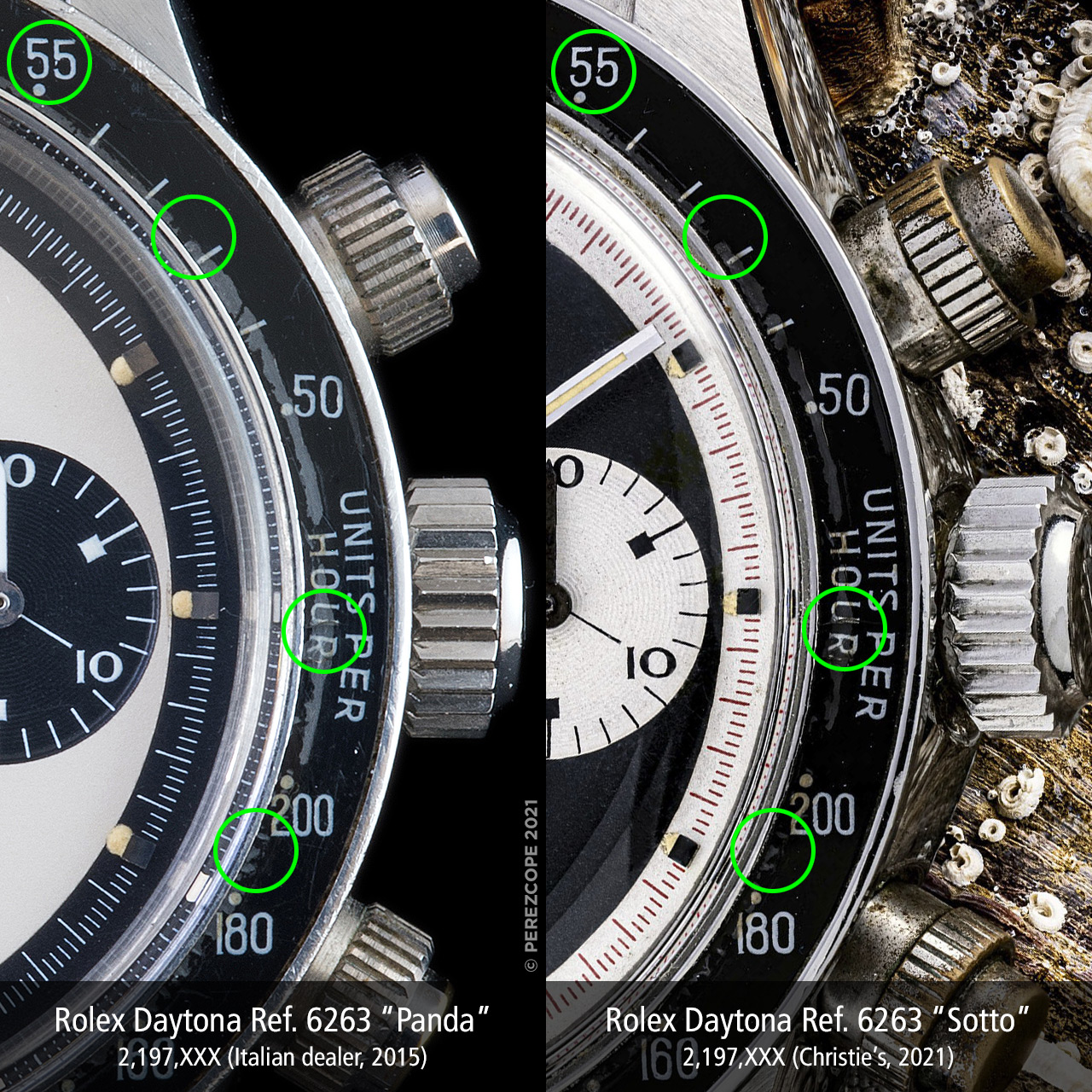
In 2017, the same watch – already in “Sotto” configuration – was offered by The Vintage Concept, a vintage Rolex dealer from Hong Kong.

The bezel is without a doubt the same but what about the case? To determine whether the case is the same as well, we need to take a closer look at the back of the case. The next picture shows the watch in its 2015 condition.
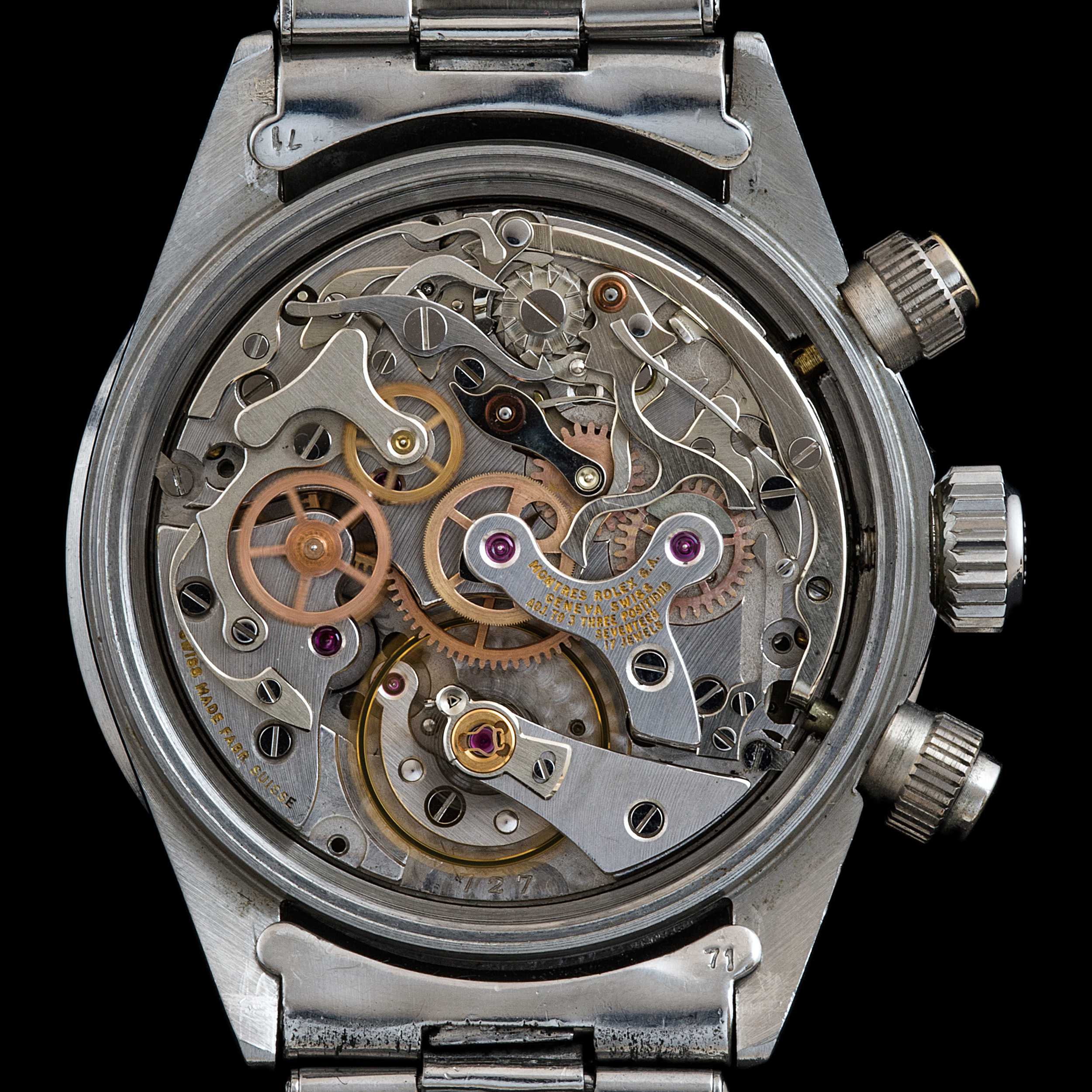
The movement picture provided by Christie’s was photographed in an unfavourable angle and has many missing areas. Unfortunately it does not help in bringing clarity as to whether the case is the same or not but if we take the picture provided by The Vintage Concept in 2017, we may have more luck.
The picture below shows the movement picture provided by Christie’s (left) next to the picture published by The Vintage Concept in 2017. To determine if a movement is indeed the same, I often compare the position of the screw heads as they are unique like finger prints. As you can see, the screw heads match perfectly, as do some scratches. This is without a doubt the very same movement.

Ok, next let’s compare the movement picture from 2015 to the one published by The Vintage Concept in 2017. See that encircled little dirt mark on the inside of the case? It’s a perfect match.
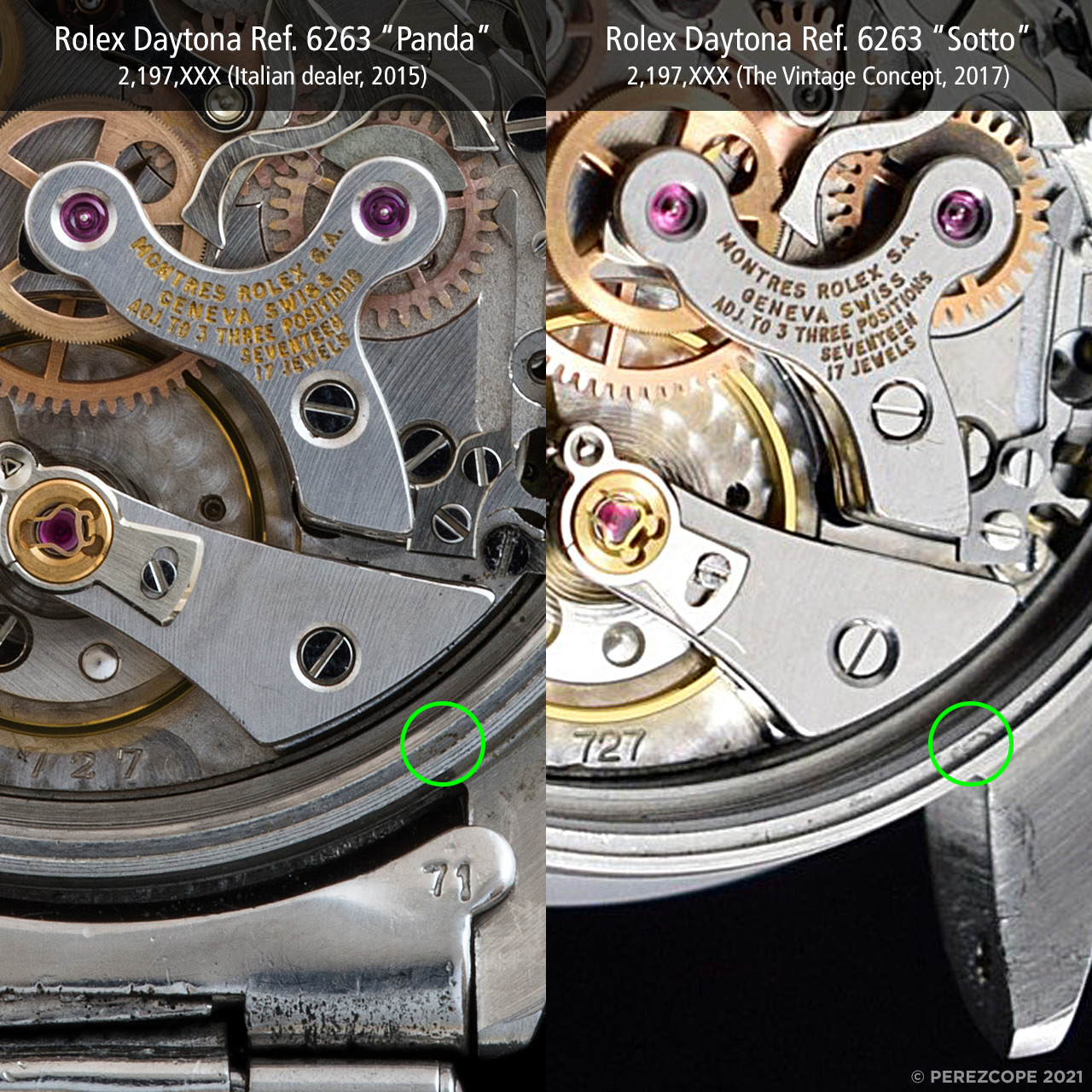
Before we continue, please check the Cal. 727 stamps. See the difference? More on this later.
A case comparison would not be complete with taking a closer look at the caseback. As you can see in the picture below, certain details between the picture from 2015 and the one published by Christie’s match perfectly as well.
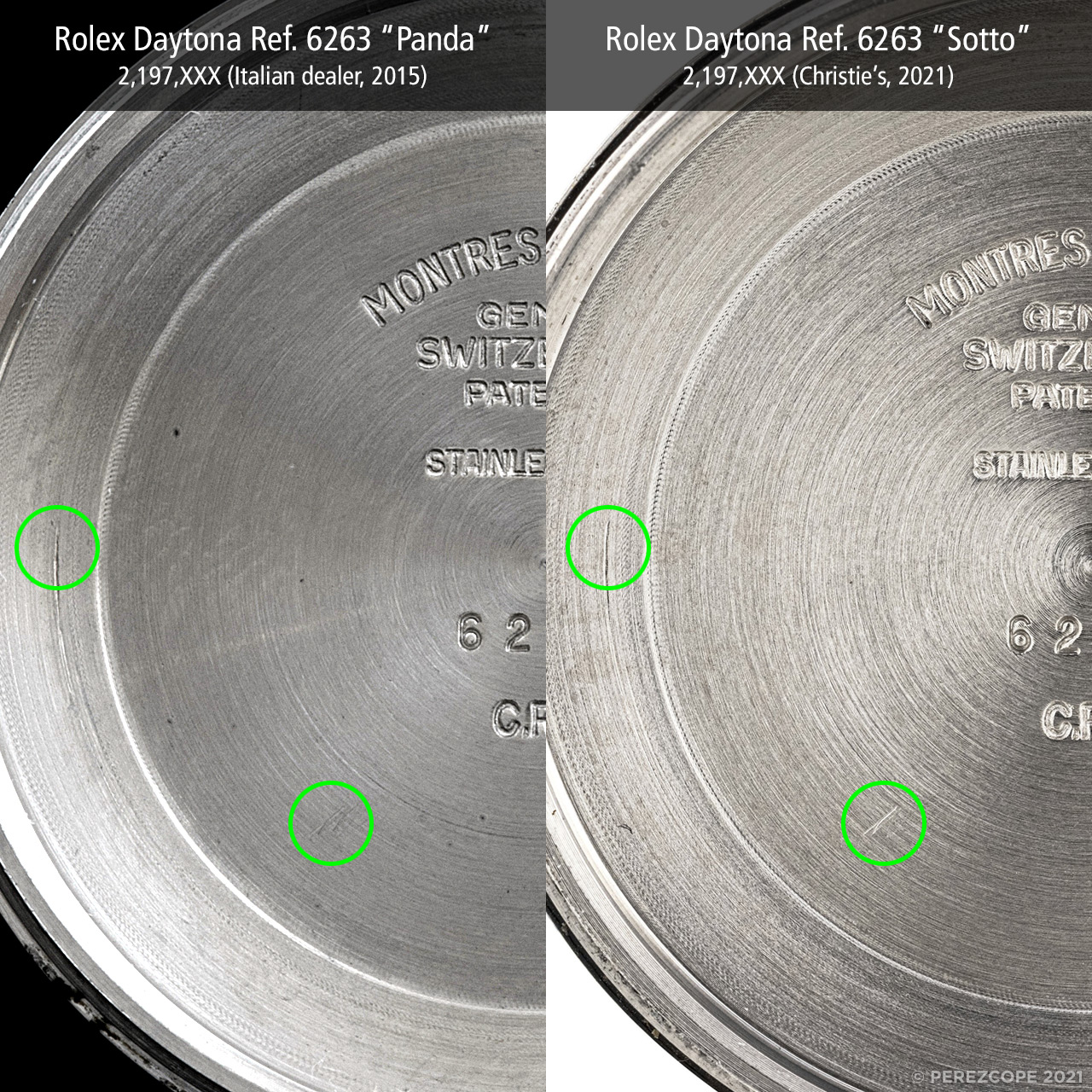
In my opinion this is pretty conclusive. There can be no doubt that this is one and the same case.
Millerighe Screw-Down Pusher
Early screw-down pusher Daytonas were equipped with so-called “Millerighe” pushers. Mille righe is Italian for “thousand lines”. The earliest version was made of nickel-plated brass and had a tendency to deteriorate relatively quick. Later “Millerighe” pushers were made of stainless steel. The ones that are installed on the present watch are quite deteriorated but that is not the issue. The problem lies in their awkward proportions. The height of the knurled ring (a) is lower than on known pushers.
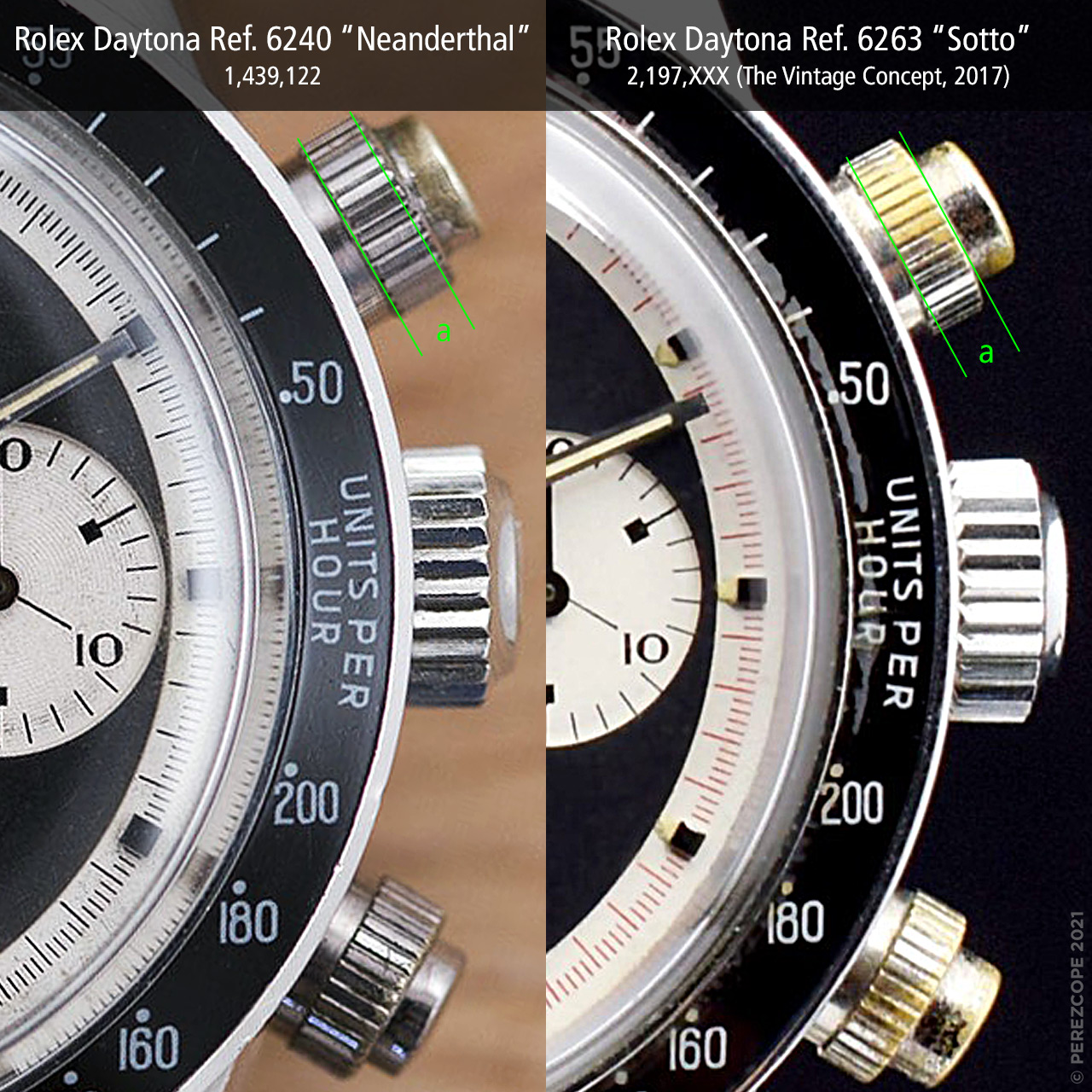
As mentioned earlier, these pushers could be fake. But regardless of their authenticity, in my opinion Daytonas from the 2.197 million case number range should already be equipped with stainless steel pushers.
Later Movement
As I mentioned in the introduction, the present watch lost its original movement when it was transformed into a rare Oyster “Sotto”. All Daytonas up to the 2.7/2.8 million range were equipped with the earliest version of the Valjoux 72-based Cal. 727. Early movements can easily be identified by their distinctive 727 caliber stamp with pronounced serifs. Later calibers were stamped with a sans-serif typeface. Another difference is the spacing between the digits which is considerably larger in early calibers (7-2-7 vs. 727).
If we compare the caliber stamps, it becomes evident that the Christie’s watch has a later movement.
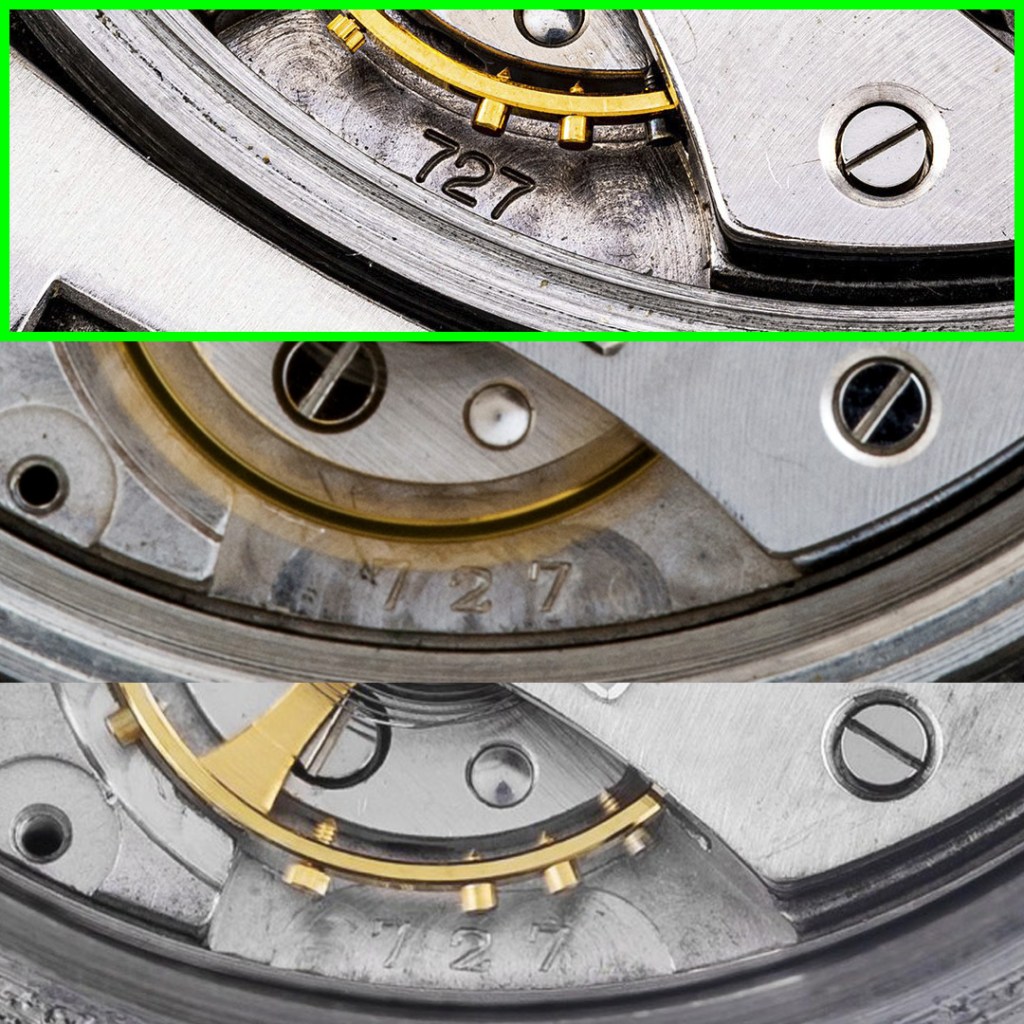
I suspect that when the dial was changed, they were too lazy to go through the process of removing the hands, unscrewing the dial from the movement and putting everything back together. Instead, they possibly just swapped the whole combo from one watch to another which is a great segue into whether the “Sotto” dial is original or not.
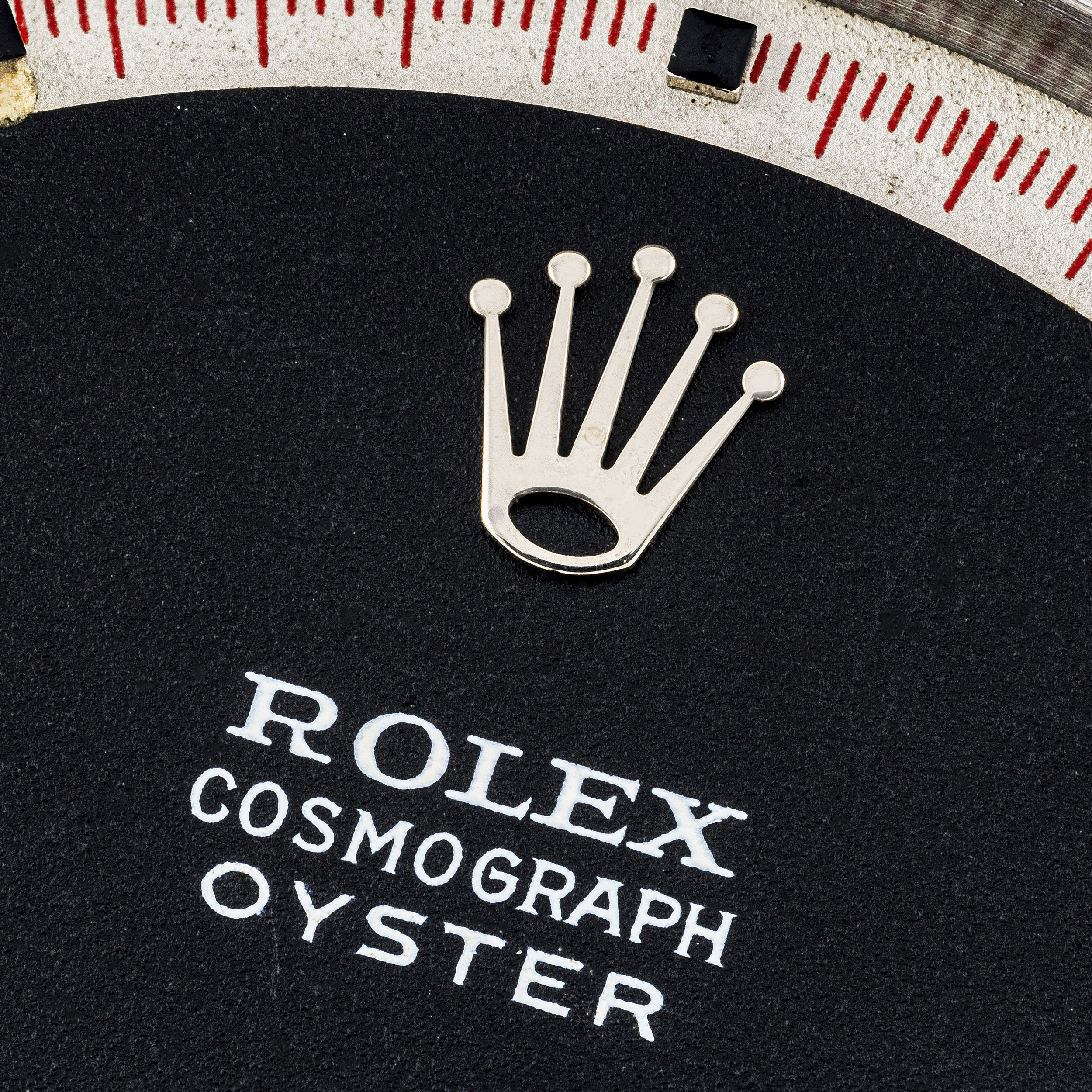
The “Oyster” print looks ok in my opinion. Given the later movement, my guess is the dial came from a later watch. There is at least one Oyster “Sotto” Mk 2 in the 2.8 million range. Since this serial range is not generally accepted as being suitable for a “Sotto”, they possibly decided to transfer the dial to something less “provocative”. For the sake of completeness, it needs to be added that certain highly knowlegeable experts do not like the “Sotto” Mk 2 variant. Some even say this version never existed.
Box & Papers
To conclude, let’s take a closer look at the box and papers that come with the watch. Christie’s boasts that their Oyster “Sotto” Mk 2 is only the second example to come with the original certificate:
“…to the best of our knowledge, only one other exists with its original certificate.”
As you can see in the comparison below, the outer carton box of the Christie’s watch (right-hand side) is the very same as the one that came with the watch in original “Panda” condition in 2015 . The green document holder is the same as well.
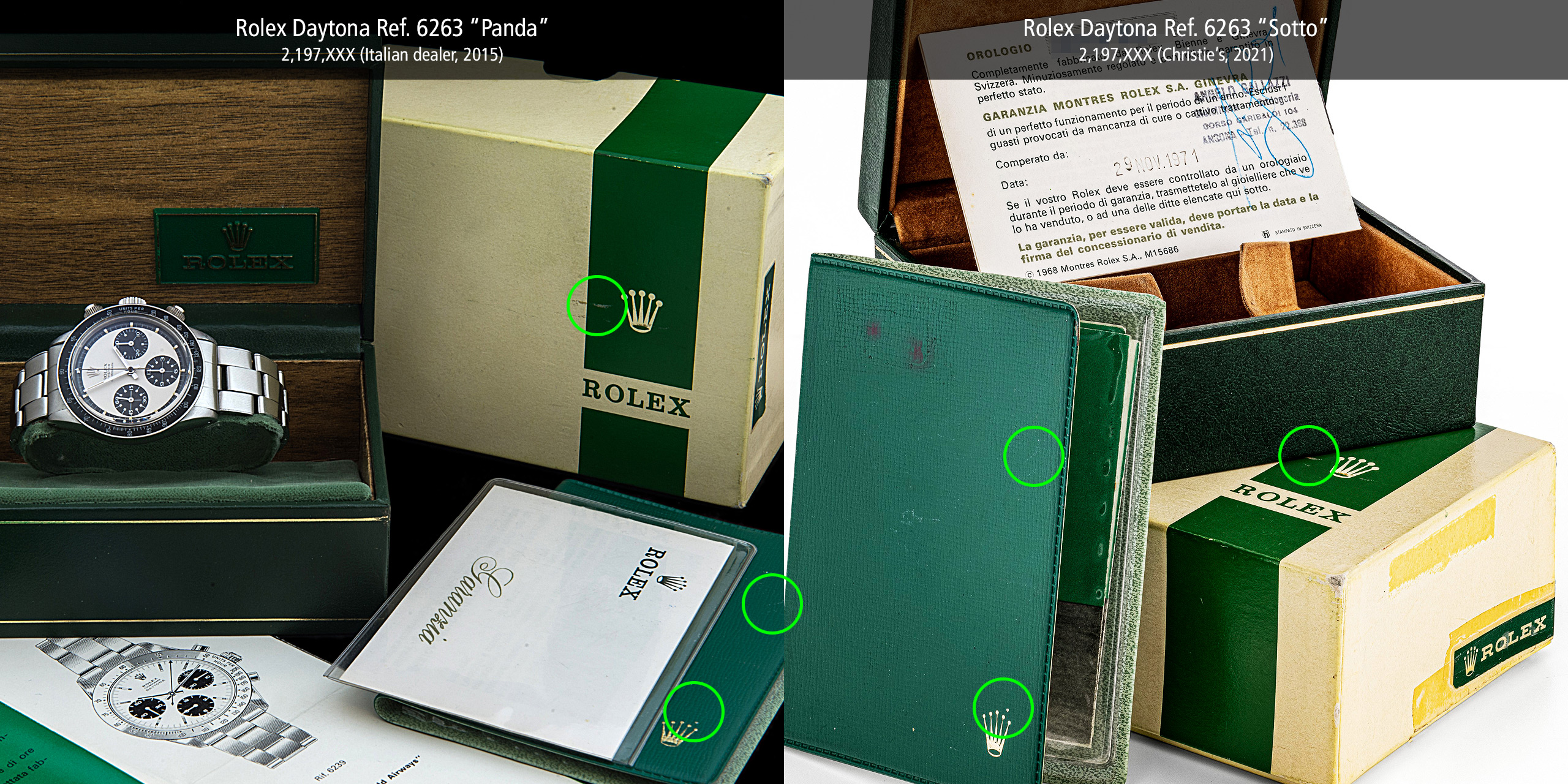
Christie’s Hong Kong is convinced they got their hands on something very special. In their description they wrote:
Christie’s Hong Kong is immensely honoured to have the opportunity to present to collectors a wristwatch that is not only an immense rarity among Rolex watches, but also could not be improved upon in terms of originality, condition and provenance.
Could not be improved in terms of originality? Is that right? Christie’s continued:
The present watch can be commended for its amazingly untouched condition…
Amazingly untouched indeed!
Update September 26, 2021
Following the publication of this article, a reader sent Christie’s HK a link to this report and asked for a response. The auction house replied they were not in a position to comment on this article but they had done their research and believe the watch is all original. Later they changed the description from:
“The present watch can be commended for its amazingly untouched condition…”
To:
“The present watch can be commended in very attractive condition…”
Clearly, Christie’s HK is acknowledging that the watch is not untouched as previously claimed but it seems they want to go ahead with the sale without disclosing its true nature. In my opinion, the right thing to do would be to withdraw the lot to avoid damaging potential buyers.
Update September 29, 2021
Christie’s went ahead with the sale and even lowered the starting price from HKD 8.5 million to 7 million (USD 190k less) but nobody placed a bid on this watch. When the time was up, the listing disappeared immediately. Lot 12, the Daytona Ref. 6240 “Solo” didn’t attract any bids either and vanished as well.
Thoughts
Oyster “Sotto” Daytonas are super rare. They belong to the pinnacle of vintage Daytona collecting, and rightly so. A real “Sotto” is more than just the dial, it is an important milestone in Rolex’s remarkable history. A “Sotto” that was not born a “Sotto” is an imposter, a deception… a fake! It is the same as with certain cars. A first series carburetor BMW 3.0 CSL is something very special. Only 169 of these ultra-lightweight cars were ever made. Sure, you could take a regular 3.0 CS and transform it into a CSL with original parts but it will never be one of the 169.
This type of exposé was made possible thanks to the sheer amount of data I was able to collect over the years. Thousands of well-documented vintage Rolex Daytonas found their way into my database. A big chunk of this data came from auction house websites where pictures and important details like case numbers, etc. were published. Since the early 2000s, there has been a continuous push for transparency coming from major auction houses and more and more details were shared. Last auction season, however, Christie’s Hong Kong made a very odd move. Out of the blue, they stopped disclosing the serial numbers of all of their watch lots. This left many in the watch community puzzled. The message seems clear. The folks at Christie’s do not welcome scrutiny. They want you to trust them blindly but as this case beautifully illustrates, they cannot guarantee the authenticity of their watches. The later movement of this franken “Sotto” should have been a warning sign to dig deeper – if one is aware of these details that is.
Thank you for your interest.

Hi, love your article and hope you and yours stay safe if you are still here. G
LikeLike
Amazing research, thank you! The collector community and just average customers need this kind of investigative research more than ever!!!
LikeLike
Top research from the top man; really enjoy these ‘exposes’ and about time these auction houses had you as a paid consultant! But I guess that might reduce the numbers of these rare and supposedly highly valuable watches that pass through their hands.
LikeLike
Keep up that perezcope and continue torpedoing the many vessels of cheat, lie, disingenuousess, acting and fraud that navigate this horological world! Hope you don’t run out of fuel anytime soon. Best.
LikeLike
Lot was pulled from auction ! Now it’s time for The Vintage Concept to explain what happened. Congratulations for your tremendous work.
LikeLike
Thank you! No, it wasn’t pulled. Nobody bid on it and the moment the time was up, the listing disappeared. What’s interesting is they reduced the starting price from HKD 8.5 million to 7 million. That’s about USD 190k less.
LikeLike
Awesome article, well written and an overall interesting read! Thanks
LikeLike
Amazing detective work! Thank you for putting Christie’s on notice that they need to do more serious due diligence with these items to earn the premiums they charge.
LikeLike
Thank you, a very interesting read.
LikeLike
excellent research, enlightening!
LikeLike
Vintage Concept of Hong Kong has been known for franken rolex watches. Be aware!
LikeLike
I like your articles. Is awesome 👏 , very informative
LikeLike
Shawn Yu talks about your article and his perspective on his YouTube channel latest video. He thinks to pursue a better “condition” it is normal for die hard vintage watch collectors like himself to combine good parts from different watches to make a perfect watch. He also says that you make a living by writing articles about possible fake watches and implied that you can be biased. What a clown.
LikeLike
Exceptional forensic work as always. I have a general question: do you think the auction houses only bother trying to pass off these types of watches that sit at the higher end of the collector spectrum, or do you believe the problem is more widespread than just on these high-end (price-wise) models?
LikeLike